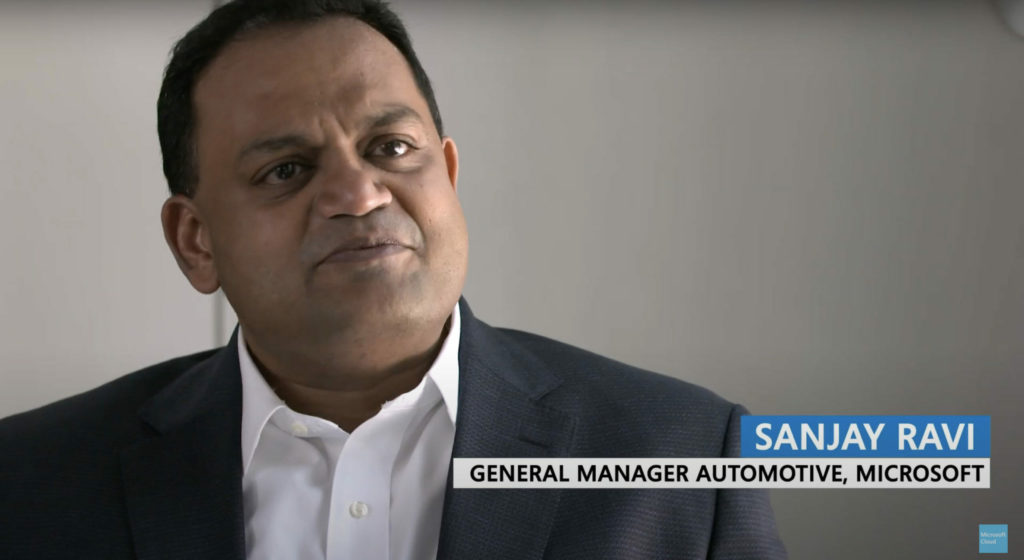As the worldwide automotive industry reimagines and recreates itself from end to end, Microsoft and the Azure Cloud are playing fundamental roles that reflect a striking revolution within Microsoft itself.
For a century, steel, manufacturing muscle and oil powered the automotive industry as car companies designed and built gas-powered vehicles owned by individuals and businesses.
Today, these newly fashioned mobility companies are pivoting rapidly to a new model driven by data-analytics and AI and centered on flexibility, autonomy and superb customer experiences.
To ensure it can support those new priorities, Microsoft is morphing as well. For decades, Microsoft has been a platform company: it created the platforms, such as Windows, and individuals and companies bought those platforms.
But in the wildly new and different world of mobility services, that one-platform-fits-all approach wasn’t enough. So as these new mobility merchants are transforming into digital companies to meet the new AI-powered and data-driven demands of customers, Microsoft has begun helping them build their own digital platforms to support those unprecedented demands.
“Customers want and need to innovate faster than they’ve ever done before.”
Sanjay Ravi, who has led Microsoft’s Automotive Industry business through these extraordinary changes during the past 8 years, said the shift from being a provider of platforms to being an enabler of platforms gives these new mobility companies the ability to move at the speed of their markets.
“We as a technology partner are in the business of helping our customers create their own digital platforms,” Ravi explained on a recent Microsoft Teams call.
“Our automotive customers want and need to innovate faster than they’ve ever done before, and they understand that to achieve that, they need to co-create with partners, suppliers and customers via their own digital platforms.”
To understand where this industry’s going, it’s helpful to understand where it’s been. A century ago, when mass-production was the emergent strategy, Henry Ford took vertical integration to new levels at the Ford River Rouge Complex:
By 1927, when Ford shifted its final assembly line from Highland Park to the Rouge, the complex included virtually every element needed to produce a car: blast furnaces, an open hearth mill, a steel rolling mill, a glass plant, a huge power plant and, of course, an assembly line. Ninety miles of railroad track and miles more of conveyor belts connected these facilities, and the result was mass production of unparalleled sophistication and self-sufficiency.
A century later, today’s challenge is no longer the mastery of end-to-end physical production of everything from steel to glass to electricity, but rather mastery over the end-to-end collection, management, analysis and deployment of data.
“Data is absolutely the key to everything.”
“Data is absolutely the key to everything we’re doing with our automotive clients,” Ravi said.
“And what is unique about Microsoft’s stance on data is that we will absolutely not attempt to monetize the data of our automotive clients—it is their data, not ours. And we fully support them in these efforts—there’s no business-model conflict from us.”
That policy extends into the new types of brand experiences the automotive/mobility companies are looking to create on the strength of first-hand data they’re collecting for customers who opt in.
“Microsoft is providing a set of very advanced cognitive services to help the car companies create their own branded experiences, like BMW’s Hey BMW digital assistant,” Ravi said.
“In turn, that helps auto manufacturers build context-specific solutions centered on the customer’s preferences and desired outcomes.”
As autonomous vehicles evolve rapidly from an experimental idea to a real-world presence, the data streams that new-age cars must be able to handle become enormous. And all that data can’t be transmitted back to some central server to be analyzed and deployed.
“We’ve worked hard to drive innovation at the edge, where advanced AI models can be executed without requiring connectivity. These intelligent edge capabilities are essential for autonomous vehicles.”
In that way, Microsoft technology helps the connected car become an enabler for the ultimate goal of the connected driver/owner/user. Ultimately, all that data and the context-specific analytics can “anticipate the needs of the person in the vehicle and support them not only in the vehicle but also support their broader digital life,” Ravi said.
Delivering unprecedented service and customer experiences through AI
The key dynamic behind these plans is the “digital feedback loop,” which allows AI tools to reason over massive amounts of data to drive optimized outcomes.
“Look at what Daimler has done with its eXtollo platform, which centralizes Daimler’s big data and analytics from end to end,” Ravi said. “This allows Daimler to create, across the entire company, digital feedback loops that its AI systems can then analyze and look for patterns.
“In the past, in general, if a person in a vehicle got an ‘error’ message, that person would have to call or go to the dealer and hope that the dealer might have the necessary parts to fix the problem. But now, the car not only sends the ‘error’ message to the person in the car, it also sends a signal to the dealer to make sure the parts are available and that the appropriate technician is on hand when the customer arrives,” Ravi said.
“That helps the automotive companies create great experiences for customers. But it also goes beyond that: if the AI systems recognize a recurring pattern of the same problems occurring, then they can raise that flag that the deeper problem might be a design or manufacturing issue that must be corrected.”
Looking to the future: Microsoft plans continued investment in automotive business
With so much happening so quickly, Microsoft’s automotive business is focusing on five key areas for investment:
- vehicle innovation across connected-vehicle and autonomous development supported by open tools and a broad ecosystem;
- smart-mobility enablers such as maps, weather, and location-based services;
- resilient operations;
- customer experience; and
- organizational productivity.
“Customers are currently experiencing so much pain; they need a partner they can trust to offer them not only technology and tools but also ideas about processes, competencies, and cultures,” Ravi said.
“That’s why everyone on our team—from developers to marketers to salespeople—are totally focused on customer success and are all totally aligned to that.”
This article is brought to you by Microsoft.








